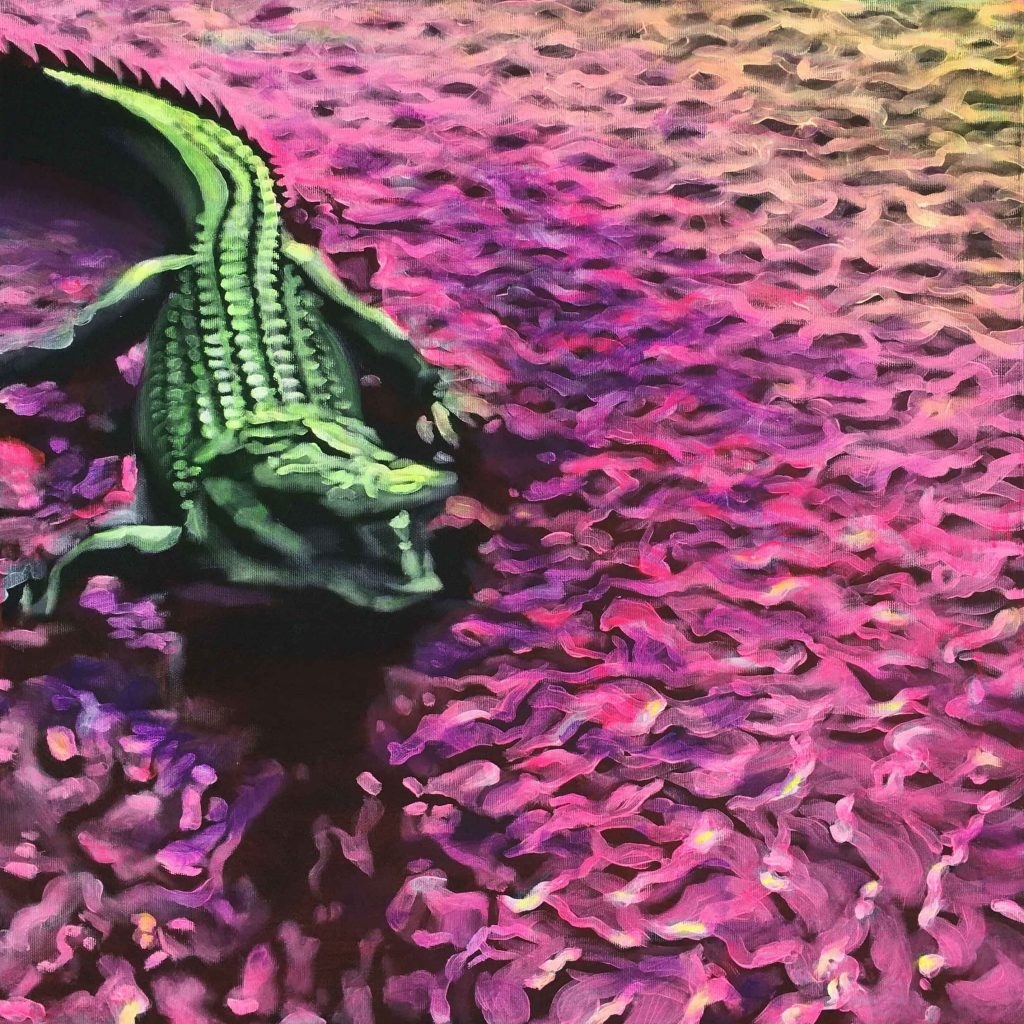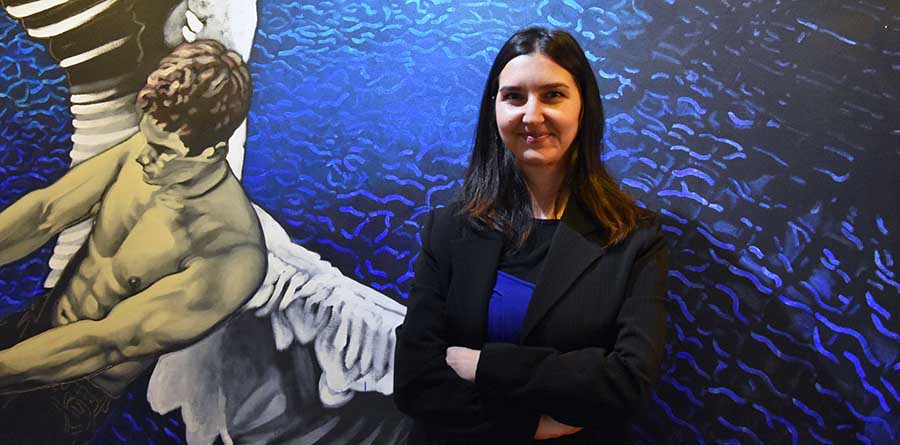Concepts from the unconscious symbolized by colors, deep dilemmas inherent in the social reality we live in and difficulties originating from our primitive desires lie at the center of Güliz Baydemir’s artistic practice. How about taking a privileged journey into Baydemir’s universe of thoughts, who sees painting as her favorite instrument of expression and whose theoretical background based on her academic identity is deeply felt in her oeuvre?
How did your interest in art begin? How did you decide to become an artist?
I spent my childhood in Thrace; I grew up in a house with a garden at a small town in Tekirdağ. The biggest factor in the germination of my passion for painting was my grandfather Salih Baydemir, a graduate of Hasanoğlan High Village Institute, Department of Architecture, and a retired painting instructor. A book on Van Gogh in his library particularly stood out for me. I lost track of time as I browsed through catalogs from the Louvre and Musée d’Orsay. When I was around that age, I used to draw copies from these books. I was also deeply influenced by images from nature. During my mid-school years at Tekirdağ Anatolian High School, I decided to take the admission exams for Istanbul Anatolian High School of Fine Arts with the encouragement and support of my family, and there I received a very high-disciplined education in painting. There I was a boarder and I spent all my time painting and reading, day and night. Following these four years, I took the admission exams for Mimar Sinan University Faculty of Fine Arts and I chose the department of painting although I passed the exam with high grades for all the other departments I applied to. Painting, that direct relationship and interaction with the surface seemed more appealing to me than any other thing. I don’t know if I managed to become an artist; but I have always loved to create.
I think we began to hear your name more often thanks to the Mamut Art Project exhibition in 2014. How did Mamut Art Project influence your career?
Mamut Art Project is a very important event that supports young artists and opens up new horizons for their careers. For me, its biggest contribution was joining the Art50.net family as a result of Marcus Graf and Güliz Özbek Collini’s visit to the 2014 Mamut Art Project exhibition.
You recently had a solo exhibition. Can we talk about it in more detail? What kind of reactions did you get? What changed between this exhibition and the earlier ones?
I had written my Master’s thesis on “Memory and Recollection in the Art of Painting”. And my first painting exhibition in Çanakkale titled “Personal Memories” took place in 2009 with the first painting series that I produced departing from my own memories. These paintings originated from sketches combining various photographs. They consisted of a reshuffling on the painting surface of the photos of various moments, places and people that I took. They were compositions with multiple figures touching upon the individual’s psychological states and relationships and containing symbolic elements. After that, “Silent Zone” was born as a series spanning over eight years where I depicted deserted man-made places with no human presence in them, and where I communicated feelings of solitude and desolation within a fantastic atmosphere. It emerged as a series departing again from my own memories and referring to the photographs I took while travelling, with a realistic drawing style but involving a symbolic or even conceptual use of color in their final stages of actualization. The series where a variety of architectural elements such as empty chairs, swimming pools, pavements, stairs and walls found reflection in mostly large-scale canvases expressed a desire to create a new order against entropy. I did the first exhibition of these series in Italy in 2012 with the title “Silent Areas” during my Erasmus exchange. Then I had the opportunity to exhibit the same series in Istanbul and Ankara as well. While the exhibition “Personal Memories” in Çanakkale focused on the individual and social relationships, seeing deserted, empty places in the “Silent Zone” exhibition that took place years later was surprising for everyone. I can say that the viewers really felt the solitude and the desolation there. And the silence… The works’ sizes also enhance this effect, of course. I was told that I turned people’s perceptions upside down. Especially in relation to the works with images of water, some people told me they felt like they were being pulled into the painting, while others were influenced by the perspective, or they felt that the paintings gradually got deeper, were excited by the colors, or surprised with the works’ objective reality effect and the effort I put into them.

In your recent works, you adopted a different color palette with colder shades like green or purple compared to your previous works. The way you use the paint seems to be different as well. The atmosphere seems to have changed quite a lot…
Yes, those works are from this year. In my earlier works, I focused on the frozen moments of the world stuck in between existence and perishing, and here, the color orange symbolized that last ray of hope for me. The color red that symbolized libido and destrudo, on the other hand, found place in my works quite often with its tension effect. According to psychoanalysis, the desire to turn back to the mother’s womb/the beginning symbolized by the image of “water” and the architecturally constructed order manifested a contrasting/intertwining relationship. And this dialectic became evident in my paintings through the simultaneous use of orange and red and their respective contrasts, blue and green. In my recent works, on the other hand, the transparent layer of orange that I applied at the final production stages of my paintings has disappeared. It was completely replaced by acrylic and much stronger shades of blue and purple. The dominance of warm colors came to an end. I actually can say that the collage series titled “Travel Bucket List” that I did last year also had an effect in it.
How did the “Travel Bucket List” collage series emerge? If we leave the formal changes aside, you again seem to freeze the viewer within a simple but highly tense moment. However, this time you used some extremely simple but strong images in addition to the deserted places. These include the crocodile and the banana… What would you like to say about this?
In my collages, instead of addressing those moments of emptiness where I existed in isolation from the chaos, I took the chaos itself as an existential problem. And in building the compositions I made use of some visuals we often come across on the internet and the social media rather than the photographs taken by me. I tried to mirror the contemporary society by creating these dream-like places with images of nature, figures and some material symbols in a way that makes you question reality. I did particularly ironic interventions on various images we are used to seeing on the internet and the social media which have an important role in the evolution of luxury’s definition. This way I wanted to explore those wild realities deeply imprinted in our memories and our state of alienation in the face of all this. On the other hand, in those works of mine in which I underlined the instinct for ‘the survival of the species’ and where I referred to ‘the survival of the fittest’ as a basic discourse in the theory of evolution and capitalism alike, I combined positive and relaxing landscapes with disturbing images. Today’s desire for ‘the freedom to realize oneself’ at the top of the pyramid of Maslow’s Hierarchy of Needs was visualized through images of ‘leisure time’, those time slots including vacations and trips during which people don’t feel obliged to respond to daily needs, cruise ships symbolizing luxurious consumption and wealth, swimming pools and animals as symbols of power. The crocodile in my recent paintings is actually one of such symbolic animals. But it’s still so lonely on the canvas… Just like the banana sitting within a gradually narrower perspective…

You have been living in Çanakkale for quite some time. How is life there? The city has recently entered Turkey’s art map thanks to the biennial. What are your thoughts on this year’s edition?
Actually, it’s been almost two years since I returned to Çanakkale. I worked here for three years in the past. The biennial is truly a very important event for the city. I can see that it attracts more and more visitors every time. My favorite spaces in this year’s biennial were Mahal Art Center and Bordo Bina.
You’re an artist with an academic career as well. How do these two areas influence each other? How do they nourish each other?
I can say it has certain positive aspects; I think they both nourish each other. In my opinion, it’s very advantageous for the students to study with an instructor who is also an artist. I also believe that being in dialogue with students lets you develop an alternative point of view as an artist and professor.
What are your projects in the near future?
I started working on a canvas series titled “Noah’s Ark” in conjunction with the “Travel Bucket List” collages. I can’t wait to share them with you as soon as they reach completion.
Click for the artist’s page.

